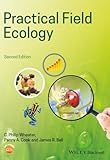Practical field ecology / C. Philip Wheater, Penny A. Cook and James R. Bell.
Material type: TextLanguage: English Publication details: Hoboken, NJ : Wiley-Blackwell, c2020.Edition: 2nd edDescription: xxxv, 424 p. : ill., photos ; 25 cmISBN:
TextLanguage: English Publication details: Hoboken, NJ : Wiley-Blackwell, c2020.Edition: 2nd edDescription: xxxv, 424 p. : ill., photos ; 25 cmISBN: - 9781119413226
- 9781119413233
- 577.072 23
- QH541.2 .W44 2020
| Item type | Current library | Collection | Shelving location | Call number | Copy number | Status | Date due | Barcode | |
|---|---|---|---|---|---|---|---|---|---|
 Books
Books
|
North South University Library | Non-fiction | General Stacks | QH541.2.W44 2020 (Browse shelf(Opens below)) | 1 | 1 | 48666 | ||
 Books
Books
|
North South University Library | Non-fiction | General Stacks | QH541.2.W44 2020 (Browse shelf(Opens below)) | 2 | Available | 48667 |
Browsing North South University Library shelves, Shelving location: General Stacks, Collection: Non-fiction Close shelf browser (Hides shelf browser)

|

|

|

|

|

|

|
||
| QH430.P54 2019 Genetics : | QH506.M65 2017 Molecular biology of the gene / | QH506.M65 2017 Molecular biology of the gene / | QH541.2.W44 2020 Practical field ecology / | QH541.2.W44 2020 Practical field ecology / | QH581.2.M65 2015 Molecular biology of the cell / | QH581.2.M65 2015 Molecular biology of the cell / |
Includes bibliographical references and index.
"This book introduces experimental design and data analysis / interpretation as well as field monitoring skills for both plants and animals. Clearly structured throughout and written in a student-friendly manner, the main emphasis of the book concentrates on the techniques required to design a field based ecological survey and shows how to execute an appropriate sampling regime. The book evaluates appropriate methods, including the problems associated with various techniques and their inherent flaws (e.g. low sample sizes, large amount of field or laboratory work, high cost etc). This provides a resource base outlining details from the planning stage, into the field, guiding through sampling and finally through organism identification in the laboratory and computer based data analysis and interpretation. The text is divided into six distinct chapters. The first chapter covers planning, including health and safety together with information on a variety of statistical techniques for examining and analysing data. Following a chapter dealing with site characterisation and general aspects of species identification, subsequent chapters describe the techniques used to survey and census particular groups of organisms. The final chapter covers interpreting and presenting data and writing up the research. The emphasis here is on appropriate wording of interpretation and structure and content of the report. New in the Second Edition There are a few new areas that have developed in the 5 years since publication of the first edition (for example, in terms of some field techniques that have become more sophisticated, laboratory techniques that have now moved into the field at an appropriate cost, and some statistical techniques that are now more accessible). In addition, it would be beneficial to update websites, references, and some of the details (especially of the researchers highlighted) within the case studies. There are a few areas where additional illustrations, new case studies (and links to further references within the existing case studies), a slight expansion of some methods, and some additional explanation of more difficult concepts could help the reader"--
Environmental Science & Management
Civil & Environmental Engineering
Sumaiya Kainat Bintey Kohinoor
There are no comments on this title.
 North South University Library OPAC
North South University Library OPAC